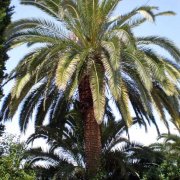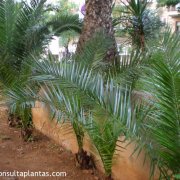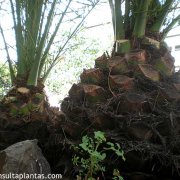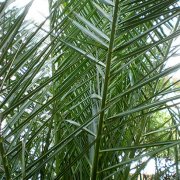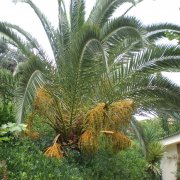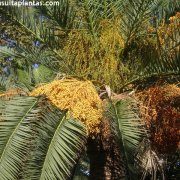Care of the palm tree Phoenix canariensis or Canary Island Date Palm |
|
The genus Phoenix, Arecaceae family, includes about 11 species of palm trees native to the Canary Islands, Africa and Asia. Some species are: Phoenix canariensis, Phoenix roebelenii, Phoenix dactylifera, Phoenix theophrasti, Phoenix reclinata, Phoenix sylvestris. Common names: Canary Island Date Palm, Canary Date Palm, Pineapple Palm, Slender Date Palm. This species is native to the Canary Islands. They are slow-growing palms that reach 20 meters (65.6 feet) in height. The long pinnate leaves, up to 7 meters (22.9 feet) long, have pointed leaflets with a bright green leaf. They produce long curved inflorescences (spades) up to 1 meter (3.28 feet) long with whitish flowers. The ovoid fruits measure 2 cm (0.78") in length. Canary Island Date Palm is used as isolated specimens, in small groups, in public parks and on streets. It's ideal for Mediterranean coastal gardens. Young plants are used in pots as indoor and terrace and patio plants. Phoenix canariensis grows in full sun, semi-shade and even shade exposures. It resists frost down to -10 ºC (14 ºF). Slender Date Palm prefers well-drained clay soil but will also grows in sandy and clay soils. Transplant pot every 3 years to renew the substrate. Water moderately waiting for the substrate to dry. Pineapple Palm resists drought and occasional waterlogging. Canary Date Palm does not need fertilizer. Prune dry leaves that disfigure the plant. Phoenix canariensis is a plant resistant to the usual pests and diseases. Canary Island Date Palm is propagated from seeds sown in spring and by separation of suckers that can be produced by the mother plant. |
Images of the palm tree Phoenix canariensis or Canary Island Date Palm |
Find plants
Phoenix canariensis or Canary Island Date Palm | Care and Growing
© 2025 FavThemes
